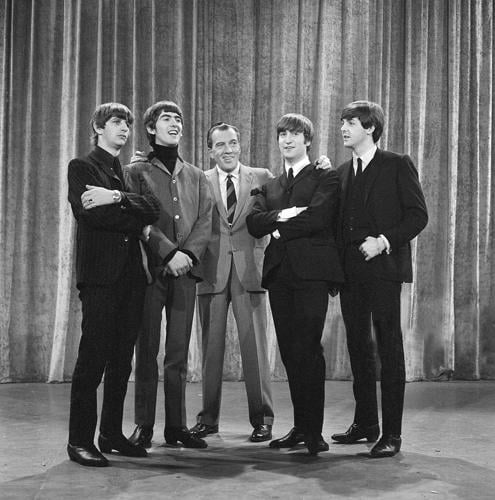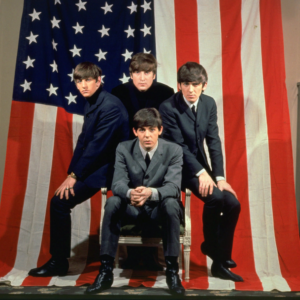On Feb. 9, 1964, a band from Liverpool, England, graced American television screens on the popular “Ed Sullivan Show” for the first time, and pop music was changed forever.
Now, 60 years later, we continue to listen to The Beatles and those timeless songs from John Lennon, Paul McCartney, George Harrison and Ringo Starr. As a reference for the younger generations, The Beatles were bigger than Taylor Swift — by record-sales metrics, anyway.
Today, McCartney and Starr are the last remaining members. Lennon was fatally shot by stalker Michael David Chapman on Dec. 8, 1980, in New York City. Harrison died Nov. 29, 2001, in California, after a long bout with cancer.
I was introduced to The Beatles through the radio and their movies. Their films show us their silliness and personalities. Their documentaries showed the toll fame took on their friendships.
In celebration of their anniversary of coming to the U.S., here are six Beatles films that should be seen. Or, as Starr once sang, “They’re going to put me in the movies/ They’re going to make a big star out of me/ We’ll make a film about a man that’s sad and lonely/ And all I got to do is act naturally.”

The Beatles with Ed Sullivan from their first appearance on Sullivan’s variety television program in February 1964. From left, Ringo Starr, George Harrison, Ed Sullivan, John Lennon and Paul McCartney.
1. “A Hard’s Day Night” (1964)
This was The Beatles’ first film, and I love that it shows off their quirky sense of humor. If ever a film was striking while the guys’ popularity was hot, it was this one. A soundtrack accompanied the film, including the title track, which was brilliant marketing. Also, this film has a great cameo, although no one knew he would grow up to be a famous musician as well. A 13-year-old Phil Collins appears in a concert scene. This film also is considered to have influenced today’s music videos.
2. “Help!” (1965)
These films aren’t exactly known for having Oscar-worthy storylines, but if you were a teenage girl in 1965, did it matter? In this one, The Beatles again play a version of themselves. This time, they’re trying to record their own album, but they’re also trying to protect Starr from a cult.
3. “Magical Mystery Tour” (1967)
The idea for this film was primarily McCartney’s in the spring of 1967, but it was put aside. After the death of their longtime manager, Brian Epstein, in August of that same year, the project got back on track. A version of “Magical Mystery Tour” premiered Dec. 26, 1967, on the BBC1. It was meant to be a little psychedelic with vibrant colors, but BBC1 premiered it in black and white. Starr supposedly called the network to complain that the film got panned because it should have been shown in color. It was later shown on BBC2 in color.
It was more like sketch TV but at times super weird. For instance, The Beatles are seen wearing animal masks while singing songs like “I Am the Walrus.” By this time, The Beatles had really stopped touring, mainly because they couldn’t hear themselves over screaming fans. Lennon was basically quoted that if they couldn’t tour, they wanted to do something that was interesting enough for fans.
![ABBEY ROAD: HISTORIA BEATLE [III]: The Night That Changed America](https://3.bp.blogspot.com/-Ea3OmMVEwYo/UvfTIopbfdI/AAAAAAAAOXM/xRQt73hokVg/s1600/Beatles_USA_Show_Cream_Shirt_POP.jpg)
4. “Yellow Submarine” (1968)
The genre for this movie is dubbed “an animated jukebox musical fantasy comedy adventure film,” and that should tell you how all over the place it is. The Beatles basically appear in most of the film as cartoon cutouts. The Fab Four really didn’t have much input on this film, except to contribute four unreleased songs, including “All Together Now.” They actually loathed “Yellow Submarine” so much that they didn’t even do the voices. An interesting note about this film is the tight turnaround for the animation. Director George Dunning had 11 months to complete it. Back then, full animated Disney features took up to four years to create.
5. “The Beatles Anthology” (1995)
This three-part television series included a three-volume set of double albums and a book. The remaining members of the group at the time, McCartney, Harrison and Starr, were interviewed for the documentary, which follows the group from its early beginnings in Liverpool to its breakup. Expanded versions were released on VHS and Laserdisc in 1996 and on DVD in 2003. The book was released in 2000. This brought a second wave of Beatlemania, as the accompanied albums included new songs and unreleased tracks.
6. “The Beatles: Get Back” (2021)
Directed and written by Oscar-winner Peter Jackson, this documentary follows the making of the “Let It Be” album, including the famous 1969 rooftop concert. The way Jackson spliced the film doesn’t show the long-held beliefs that they argued the whole time. Instead, it shows their creative process. It looked like they were not getting any further on songs and then — boom — they were ready. A few things in this film that should be mentioned. McCartney shows off his Type-A personality and comes across sometimes as a control freak, which, in all fairness, he is.
Pay attention to Yoko Ono and Harrison’s conversation. Although the two had a contentious relationship, Ono is seen supporting Harrison, who said they should work on solo projects and then come back as The Beatles. Ono has long been the scapegoat for the band’s breakup, but this documentary reveals the cracks that had already formed within the group, long before Lennon met Ono.
The Beatles performed their last official concert in August 1966 at San Francisco’s Candlestick Park. However, the last time they performed together live was the 1969 rooftop concert — not exactly a public concert, but it could be heard from the surrounding streets of London. The following year, McCartney released a press release saying he was no longer with the band, which, for some diehard fans, marked their official breakup. But it took until 1974 before the band legally dissolved.
Today, the lone surviving Beatles still get together to perform. McCartney has made several appearances at various Ringo Starr & His All-Starr Band concerts.
The Beatles are considered the most influential band in history. And maybe 60 years from now, someone else will be discussing their “Long and Winding Road,” too.
